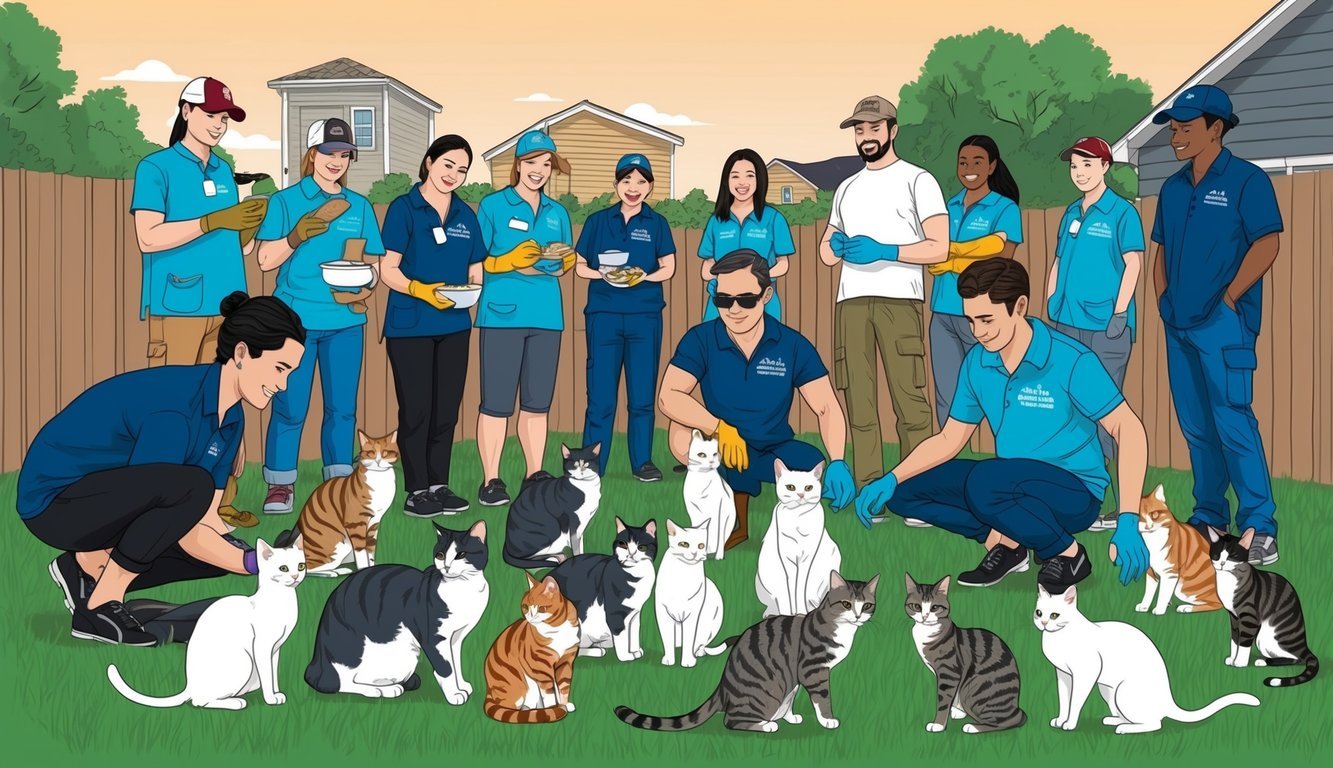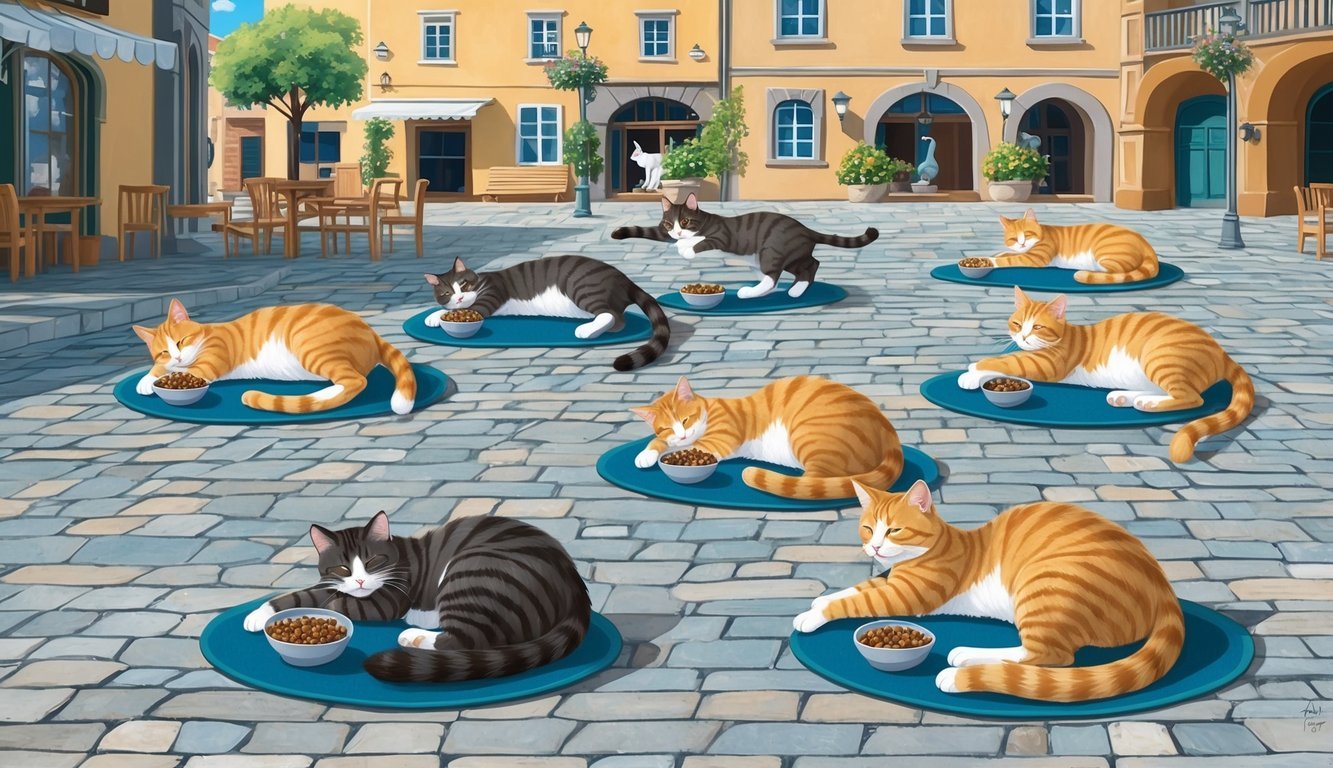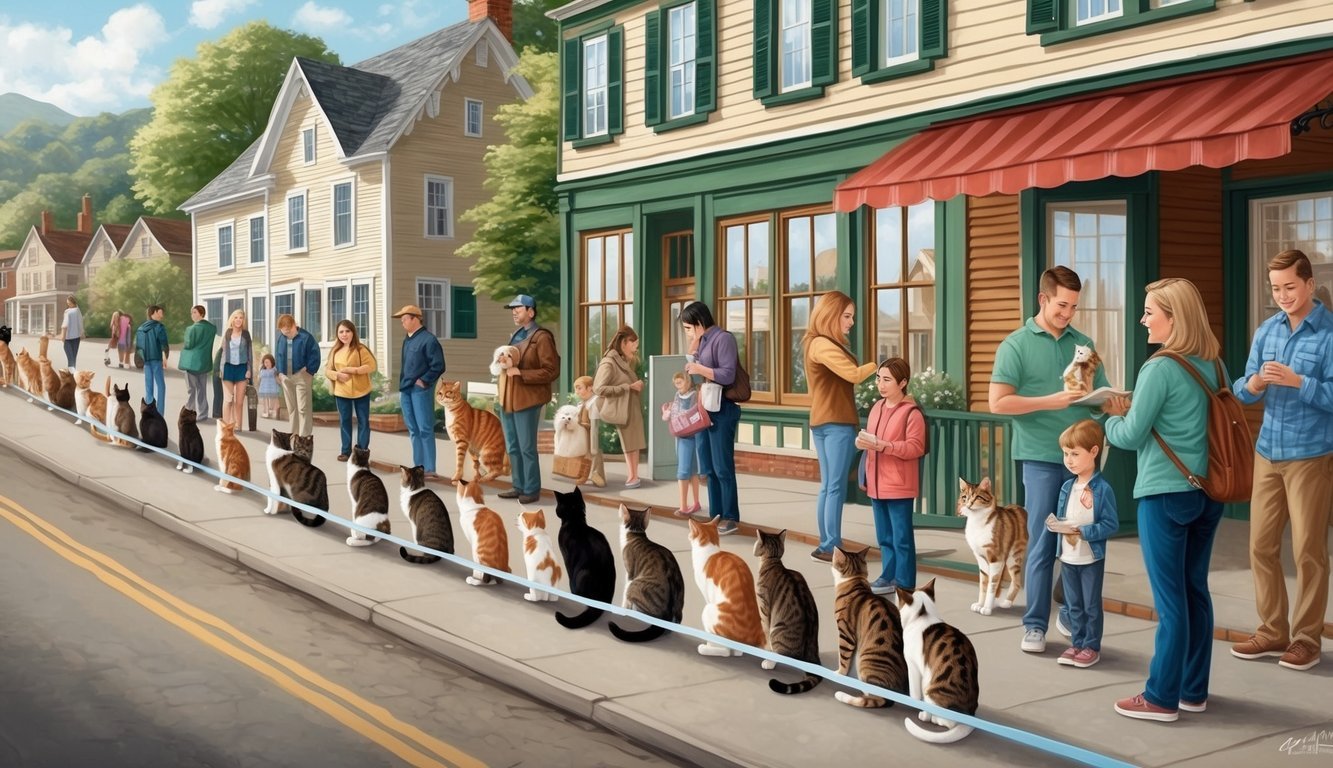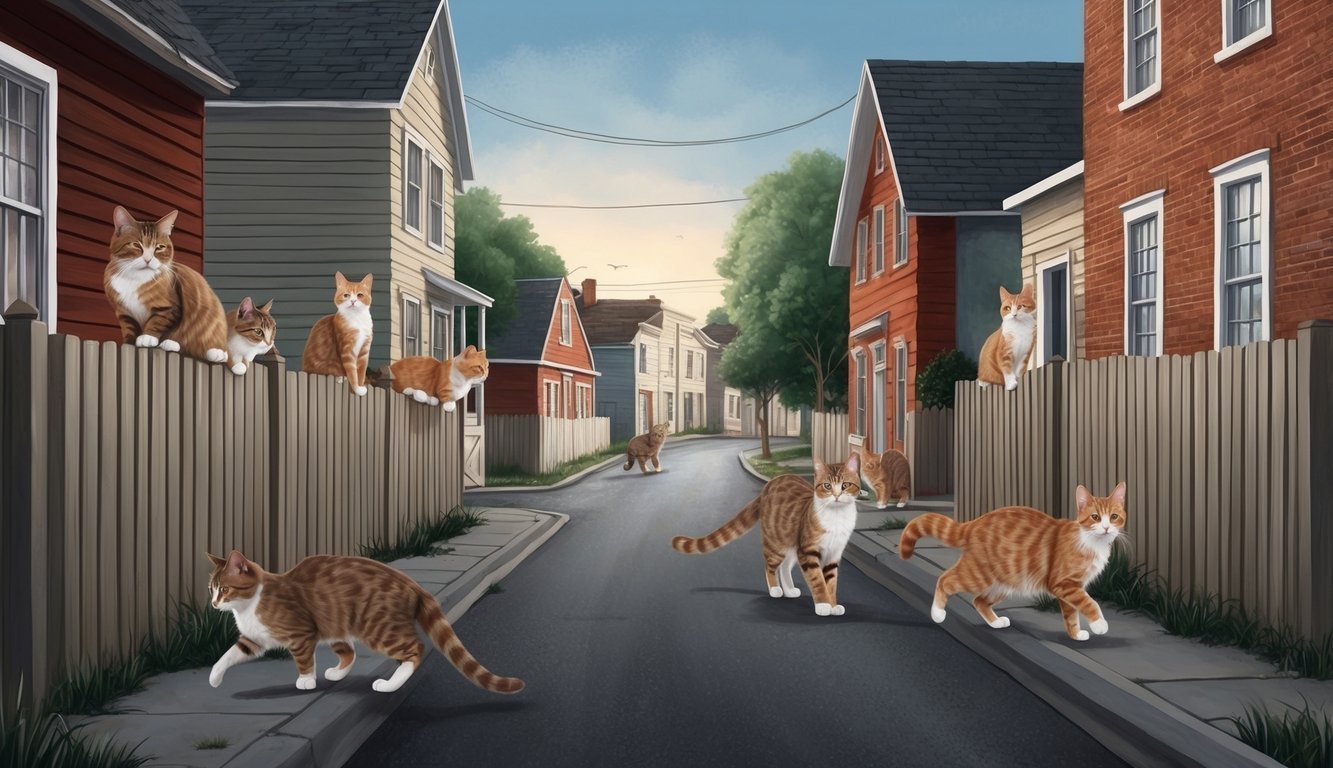Town Cats focuses on rescuing and caring for stray and abandoned cats in your community.
They promote responsible pet ownership and compassionate care.
By supporting their mission, you can be part of a movement that not only saves the lives of these cats, but also enhances your local community.
Whether you’re considering adopting a feline friend or looking to contribute through donations or volunteering, Town Cats provides various ways to get involved.
The organization plays a vital role in managing the cat population through humane programs like Trap/Neuter/Return (TNR).
They also offer adoption services that ensure these animals find loving homes.
The efforts of Town Cats extend beyond simple rescue; they aim to improve the overall health and welfare of cats while educating the community about responsible pet care.
As you read on, discover how you can partake in these initiatives and learn more about the available cats waiting for adoption.
Together, you can make a significant difference in the lives of these animals and help create a more caring environment for all cats in your area.
Key Takeaways
- Town Cats offers various programs for the rescue and well-being of local stray cats.
- You can support Town Cats by adopting, donating, or volunteering your time.
- The organization promotes responsible pet ownership and community education.
Understanding Town Cats

Town cats often represent a complex interaction between feral and homeless species.
Understanding these distinctions can illuminate the challenges they face, especially with population growth affecting their lives.
Differences Between Feral and Homeless Cats
Feral cats are typically wild and live independently from humans.
They often avoid human contact and can be found in colonies.
Their survival hinges on their instincts and hunting skills.
On the other hand, homeless cats usually have had some human interaction but lack a stable home.
They may rely on humans for food and shelter, making them more social.
Here’s a quick comparison:
| Feature | Feral Cats | Homeless Cats |
|---|---|---|
| Socialization | Avoid humans | Interact with humans |
| Dependence | Self-sufficient | Rely on human aid |
| Habitat | Outdoor colonies | Various environments |
The Impact of Population Growth on Town Cats
Population growth significantly affects town cats.
As more people move into urban areas, the number of stray and feral cats tends to rise.
This increase can lead to resource depletion, causing competition for food and shelter.
Overcrowding can also facilitate the spread of diseases among these cats.
Key implications include:
- Overpopulation: A larger number of cats leads to strained resources.
- Health Risks: More crowded conditions mean higher disease transmission rates.
- Community Impact: Increased cat populations can affect local wildlife and public health.
By understanding these dynamics, you can better appreciate the challenges town cats face and the importance of responsible pet ownership and community support.
Community Efforts in Cat Management

Community cat management relies heavily on collaborative efforts among residents, organizations, and volunteers.
These initiatives often involve practical solutions like Trap/Neuter/Return (TNR) programs and the dedication of volunteers who care for the welfare of town cats.
The Role of Volunteers in Helping Town Cats
Volunteers play a crucial role in managing community cats.
They often provide their time, resources, and energy to support local initiatives.
Tasks may include feeding, providing shelter, and monitoring the health of the cats.
Volunteers can also help with outreach, promoting awareness about the importance of humane cat management.
They educate others about TNR techniques, which can foster community involvement.
By establishing a network of supporters, you can create a sustainable framework that addresses both the needs of the cats and the concerns of residents.
Your involvement as a volunteer not only improves the lives of local cats, but also contributes to a sense of community.
Forming partnerships can significantly amplify your impact.
Trap/Neuter/Return Programs
TNR programs are among the most effective methods for controlling the population of community cats.
These programs involve humanely trapping cats, sterilizing them, and then returning them to their original location.
This approach helps reduce the number of unowned cats over time.
To achieve success with TNR, you need to sterilize a significant portion of the cat population—typically around 80%—in the targeted area.
This can lead to a substantial decrease in the number of kittens and free-roaming cats.
Implementing a TNR program often involves collaboration with local animal shelters and veterinary services.
Engaging volunteers for trapping and managing the care of the cats ensures that the program runs smoothly and effectively.
When communities come together, they can create a sustainable, humane solution for managing town cats.
Health and Welfare

Caring for town cats involves ensuring their health and welfare through proper medical care and offering support during recovery.
These aspects are critical to maintaining their quality of life and managing their populations effectively.
Importance of Medical Care for Town Cats
Providing medical care for town cats is essential for their physical and mental well-being.
Regular check-ups and vaccinations help prevent diseases such as feline leukemia and rabies.
Routine spaying and neutering are vital to control population growth and reduce health risks associated with mating behaviors.
You should also be proactive in monitoring for common health issues.
Look for signs like:
- Weight loss or gain
- Behavioral changes
- Problems in grooming
Early detection can lead to better outcomes.
Ensuring that town cats receive prompt veterinary attention can prevent minor issues from escalating into serious health problems.
Collaborative efforts with local veterinarians and animal welfare organizations can facilitate access to these essential services.
Providing Foster Homes for Recovery
Foster homes play a significant role in the recovery of town cats that require medical attention.
After spaying, neutering, or treatment for illnesses, these cats often need a safe and quiet space to recuperate.
Foster caregivers can provide a nurturing environment where cats receive:
- Proper nutrition
- Necessary medications
- Socialization opportunities
This helps reduce stress and speeds up healing.
If you consider fostering, prepare a separate area in your home where these cats can feel secure.
Equip it with basic essentials like food, water, and a cozy bed.
Engaging with local rescue groups can connect you with cats in need of fostering, making a meaningful impact on their lives.
Adoption Process

Adopting a cat involves a straightforward application process and understanding the associated fees.
Here’s what you need to know to make this experience smooth and rewarding.
How to File an Adoption Application
To begin your adoption journey, you need to complete an adoption application.
You can do this by visiting Town Cats during their open hours or by contacting them via email to set up an appointment.
The application generally collects information about your living situation, previous pet experience, and what you’re looking for in a cat.
Make sure to fill it out completely for a better chance of approval.
Once submitted, the team will review it and may follow up with questions or set up an interview to discuss your application in detail.
If approved, you’ll be guided through selecting a cat, ensuring it’s a good match for your lifestyle.
Understanding the Adoption Fee Structure
The adoption fee helps cover the costs associated with caring for the cats, including medical expenses.
Here’s a breakdown of typical fees:
- Kittens (up to 6 months old): $250 each
- Pair of Kittens: $400
- Adults (6 months to 8 years): $200 each
- Pair of Adults: $300
- Senior Cats (7+ years): $100 each
- Bonded Pairs of Seniors: $150
These fees contribute to affordable adoption services that ensure every cat is spayed/neutered, vaccinated, and checked for health issues before going to their new homes.
This commitment not only benefits the cats, but also supports community initiatives.
Be prepared to pay the fee at the time of adoption to finalize the process.
Spotlight on Ocean City

In Ocean City, Maryland, community efforts are actively enriching the lives of local cats.
This vibrant area showcases remarkable achievements in managing the feline population while advocating for animal welfare.
Success Stories in Ocean City
You’ll find numerous success stories emerging from Town Cats, the local organization dedicated to improving the lives of feral and abandoned cats.
Through the Trap/Neuter/Return (TNR) program, many cats have been spayed or neutered.
This reduces their population over time.
Adoption events have led to many cats finding loving homes.
Local residents often share heartwarming tales of cats transitioning from the streets to cozy living rooms.
Whether it’s a feral cat becoming a family pet or a kitten finding its forever home, these stories inspire future efforts.
How Ocean City Manages Local Cat Population
Ocean City employs several strategies to effectively manage its cat population.
The TNR program is a cornerstone of this approach.
Volunteers set traps to catch feral cats, provide necessary medical care, and then return them to their original locations.
On regular Saturdays, community members can meet adoptable cats at the Ocean Pines Farmer’s Market.
This not only boosts adoptions, but also raises awareness about the importance of spaying and neutering.
Moreover, local businesses, like Petco, regularly host events to showcase available cats.
This interaction encourages responsible pet ownership and fosters a compassionate environment for our furry friends.
Supporting Town Cats

Every bit of support helps Town Cats in their mission to care for feral and abandoned cats.
You can contribute in meaningful ways, either through donations or by becoming a volunteer.
Making Donations to Help Town Cats
Your donations can make a significant impact.
If you contribute as little as 85 cents, that amount directly supports lifesaving programs for cats.
Town Cats utilizes these funds for vital services, including medical care and adoption services.
Consider making a one-time donation or setting up recurring contributions.
Options may include cash, supplies, or even services.
Every donation is an investment in the well-being of the community’s felines.
You can donate through their website or directly at their facilities.
Volunteer Opportunities and How to Get Involved
Volunteering is another fantastic way to support Town Cats.
They are always looking for enthusiastic individuals to join their efforts.
Roles can range from shelter care and fostering to transporting cats and adoptions.
You can also assist with administrative tasks, marketing, or organizing donation drives.
To get involved, reach out to Town Cats via their website or by phone.
They appreciate your commitment and are ready to guide you on how to make a difference!
Frequently Asked Questions
If you’re curious about adopting a cat, volunteering, or finding local cat shelters, you’ve come to the right place.
Here’s what you need to know about each topic.
How can I adopt a cat from a local town cat rescue?
To adopt a cat, start by visiting the local rescue’s website to view available cats.
Often, you can fill out an application and schedule a visit.
Be prepared to answer questions about your living situation and what kind of cat you’re looking for.
What steps should I take to volunteer at a cat rescue center?
To volunteer, reach out to the cat rescue directly.
The cat rescue usually has an application process.
After that, you may attend an orientation or training session to understand your responsibilities.
Are there specific requirements to surrender a cat to a town cat shelter?
When you surrender a cat, most shelters require you to fill out a form detailing your cat’s health and behavior.
Some may also need proof of vaccination and may ask for a small fee.
Contact your local shelter to check their specific guidelines.
What are some tips for visiting cats at places like Mini Cat Town?
When visiting places like Mini Cat Town, approach cats quietly to avoid startling them.
You can sit calmly and allow them to come to you.
Always follow any specific rules provided by the staff.
How do I find cat shelters or rescues nearby?
You can find local cat shelters by searching online with terms like “cat rescues near me.” Check social media platforms and community boards for recommendations on reputable shelters in your area.
Can I meet the town cats of specific areas like Ocean City?
Yes, many areas have community cat programs.
You can often meet these cats through local rescue groups that manage these colonies.
Contact local organizations to find out about any events or opportunities to interact with the cats.


